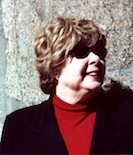Gjesteredaktør Marjorie Perloff

Marjorie Perloff is one of the foremost American critics of contemporary poetry. Her work has been especially concerned with explicating the writing of experimental and avant-garde poets and relating it to the major currents of modernist and, especially, postmodernist activity in the arts, including the visual arts and cultural theory.
Anbefalinger
The American Sculptor Carl Andre turns out to also be a major art theorist/poetician. His interviews, dialogues with Hollis Frampton, and statements about art are beautifully assembled here by James Meyer. I found the book an eye-opener. Andre was largely an auto-didact; he had absorbed so much poetry and really understands how language works.
This new selection of recent poems, performance pieces, visual works, and lectures by the important Anglo-Norwegian poet-performance artist has, aside from the remarkable versions of Chaucer of the title, the really powerful sequences Cropper and Goan Atom (two of my Bergvall favorites), and the meditation on language «Cat in the Throat».
There are so many translations of Dante that one wonders, why one more? But Mary Jo Bang’s is unique: She faithfully follows the narrative and central imagery of the Italian text and yet brings it into the present by using contemporary syntax and argot so that Dante’s stories are made entirely new – and very dramatic. The famous stories – e.g. Paulo and Francesca – thus become quite graphic. Bang also has great notes on the various cruxes in the Inferno.
If you can’t read Portuguese (I can’t), this bilingual edition (Portuguese/French) by the poet Jacques Donguy will help you very much to understand what a remarkable varied poet we have in Augusto de Campos. A beautifully designed and delightful book that covers the various phases of de Campos’s career.
Dworkin is probably best known for the anthology of conceptual poetry he put together with Kenneth Goldsmith (Against Expression: An Anthology of Conceptual Writing. Agm Collection 2010), but this is the theoretical book that stands behind the choices in the anthology as well as his own poetry. Covers a wide range of writing practices from the Situationists to John Cage and Jackson MacLow to Susan Howe and American poets.
The printface is faint, the paper cheap, but at least we finally have a good selection of this major poet, with a great introduction by his son Alec. From the early concrete poetry to the making of the garden Little Sparta, it’s all here and should give Finlay a much bigger audience.
Goldsmith is well known for his appropriation of the New York Times (Day) and the trilogy, WEATHER, TRAFFIC, SPORTS, but before he wrote in his appropriative mode, he wrote the wonderfully funny and complicated rule-governed text called No. 111, where he moves all the way from single syllables to D. H. Lawrence’s The Rocking-Horse Winner, using all words that end with the sound schwa (er).
The heart of this project is Statement of Facts, Place’s poetic assemblage of narratives taken from court testimonies dealing with the appeals cases of sexual offenders. Place, herself an appellate attorney in Los Angeles, shows that a narrative built entirely on the facts (in this case, of testimony in the cases of felons convicted of rape) can be more intriguing, enticing, and devastating than the most elaborate fiction. The second volume, Statement of the Case, sets forward the procedural history of the case, and the third, Argument, gives us the claims of error and (for the defense) the arguments for reversing judgment. To read Tragodia is to learn that nothing is black and white, that in crime as in «evidence» and explanation, mystery and complexity reign.
Contains the wonderful, long out-of-print «Serial Biography» where this most elusive and indirect of poets produces a very moving memoir and I also love «Letters from Yaddo» – diary from the writer’s colony.




















